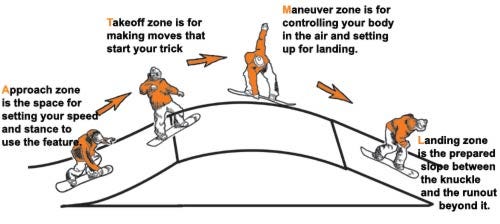
Ways to improve your snowboard kicker skills
If you want to improve your chances of success on kickers it’s well worth thinking about everything before the kicker. I use the American system of Approach, Takeoff, Manoeuvre and Landing to break down every move. This is illustrated in the graphic below.

We often discuss freestyle snowboarding in terms of putting in the least amount of effort to come out looking the best you can. You can easily see that with top level riders. It looked effortless. In the movies they’re pulling 10's yet you are struggling to get your 180 to become a 360.

Keep it simple
Most peoples riding could do with some improvement. The problem is, developing your riding skills is neither glamorous nor exciting, especially in a dome. Yet a lot of riders will only go so far with their freestyle because they cannot effectively balance, tilt or manipulate their boards. They will hit a frustrating plateau and most likely end up in a loop of the same old tricks as they cannot unlock the next level without frequent slams. If you feel that might be happening then it’s well worth sourcing some coaching to look at your riding and highlight some improvements.
From a coaches perspective, our aim is to use the skills you have in a way that will get you some solid freestyle results. That often means minimising the negative impact of any weak board performance skills by simplifying the movements required to get the desired results.
It’s all in the Approach
Think about if you were mountain biking. How do you avoid falling off the bike? You maintain a nice comfortable speed. You remain balanced on the bike pointing where you want to go. If you’re starting weaving around on your bike or trying to skid around on a trail you’ll most likely end up in the bushes.
Why should snowboarding towards a feature be any different? With any freestyle move, you’re trying to get from A to B with a bit of personal flavour in the middle, i.e. a trick. There is little value in extra movements on the way into a feature.
Kickers require a higher degree of board control skills to achieve safe results which is why a lot of people struggle with them (especially when moving onto bigger kickers). The most common thing we see is excessive turning and speed checking on the way into a jump, coupled with poor balance and posture on the board (chest facing downhill).
The more you skid or speed check, the more you’ll most likely be using your upper body through separation to initiate those moves. This will effect your balance and ability to make adjustments to the board. This can become worse as you accelerate towards or up the jump. You’ll also be less able to select the appropriate edge for the trick you want. This will often result in a slam (see video).
You should aim to keep your upper body movements to a minimum and create clean and tight lines towards the kicker.
Kicker Approach Tips
1 — Pick a drop point -
Don’t start miles away from the kicker, otherwise you’ll have to add in lots speed checks. Pick a safe drop point that will enable you to cover the right distance past the knuckle. You can adjust your drop point depending on what trick or how conditions evolve as your session develops. If you are hitting a series of jumps, then side slip/speed check once you’ve landed the jump until you feel you have the right speed to then start the new approach phase. Use some kind of slope marker to help identify your drop point. This could be some rocks, lift pylons, piste markers etc.
2 — Be in charge -
Quite often people will drop straight into a jump totally flat base. This creates the cat track effect where you’re not in total control of the board. The snow is starting to dictate where you go and you have a much higher chance of edge catch, especially as you get compression from the kicker (see video). Try to be decisive with your edge selection, so your cutting through the snow, not being thrown around by it.
3 — Get in front of your target -
If your aim is to get over a jump then make sure you start in front of it. Quite often people will start way off to the left or right of the kicker, therefore having to make a lot of turns to then start focusing on their approach.
4 — Pay attention to Posture -
Get someone to video your approach into a jump. Have a look at your line in addition to your posture. Is your weight balanced between both feet? Is your back arm drifting round in front of you affecting the weight distribution on the board. Most commonly, people will have a bias towards their back leg and ride open (facing downhill). This will mean that on some jumps the compression from the transition will result in a shift onto the heel edge and possible rotation on the face or in the air (see video). Not the best thing to have when you were planning on a straight air. Push your knees out to help balance your weight and tap your back pocket to help keep you aligned.
Try and test yourself with your path into the jump. Can you see any nice lines or is the snow being sprayed around. Nice lines means more control and consistent speed.
Happy flying.
James Streater is the Head Coach and Founder of Maverix Snow Ltd, a snowboard coaching company. James dips into his 16 years of snowsports experience to comment on the snowsports industry and ways to improve your on slope experience. Follow him on twitter @maverixsnow
Originally published at www.maverix.org.
